sen. patrick leahy renews subpoena threat -- still no documents from the white house! -- may 16, 2007
more on this shortly, but
it is time to issue the rest
of those subpoenas, chairman leahy. . .
probably the most difficult passage
in the letter relating to karl rove:
". . .According to Allen Weh, Chairman
of New Mexico's Republican party, when he
asked Mr. Rove during a holiday party in
2006 “is anything ever going to happen to
that guy?” -- referring to Mr. Iglesias -- Mr.
Rove responded, “He’s gone. . ."
Fred Fielding, Esq.
Counsel to the President
The White House
1600 Pennsylvania Avenue, N.W.
Washington, D.C. 20500
Dear Mr. Fielding:
I have reached out to you many times during the past two months seeking voluntary cooperation from the White House with the Judiciary Committee’s investigation into the mass firings and replacements of U.S. Attorneys. To date the White House has not produced a single document or allowed even one White House official involved in these matters to be interviewed.
It appears from the evidence gathered by the Committee in five hearings, eight interviews with current and former officials from the Department of Justice, and review of the limited documents produced by that Department that White House officials played a significant role in developing and implementing the plan for the dismissals. Indeed, the plan seems to have originated in the White House and was formulated by and with coordination of the White House political operation.
Along with nine other Members of the Senate Judiciary Committee, I sent you a letter on March 22, 2007, explaining why your “take it or leave it” offer of off-the-record backroom interviews was unacceptable because it would constrain the Committee’s and the public’s access to key information and prejudge the outcome of the investigation. Republican Members of the Committee have publicly and privately recognized that such off-the-record meetings are inadequate, as well. In a letter I sent with Chairman Conyers dated March 28, 2007, I tried to work with you to find ways to narrow our dispute by gaining access to documents you had offered to provide as a way to further our investigation. Your response has been to restate your initial, unacceptable “take it or leave it” offer.
We learned from press accounts that the White House cannot account for the e-mails of almost two dozen people at the White House, including some the Judiciary Committee has asked to question in connection with its ongoing investigation. The White House has since admitted that these officials utilized e-mail accounts, addresses and equipment provided by the Republican National Committee and Republican campaigns to communicate about the plan to replace a number of United States Attorneys.
To date there has been no production of relevant e-mails to the investigating Committees. I have since learned that the White House has requested that any e-mails relevant to the Committee’s investigation that are in the custody, control or possession of the Republican National Committee, be turned over to the White House rather than directly to the Judiciary Committee. The Republican National Committee has apparently agreed.
The refusal of the White House to provide relevant documents and access to White House staff who played significant roles in these firings and in the encroachment of politics into law enforcement presents an obstacle to the ability of Congress and the public to get to the truth. The Committee has learned in documents and then heard in the testimony of Attorney General Gonzales, his former Chief of Staff Kyle Sampson, and other high-ranking Department of Justice officials, that Karl Rove, Mr. Rove’s deputies Sara Taylor and Scott Jennings, former White House Counsel Harriet Miers, and Deputy White House Counsel William Kelly, were involved.
In fact, White House officials have been involved at every step of the plan to replace the U.S. Attorneys:
- We have learned that Karl Rove and then-White House Counsel Alberto
 Gonzales were involved from the beginning in plans to remove U.S. Attorneys. According to documents obtained from the Department and Mr. Sampson’s testimony, Mr. Sampson discussed the plan with then-White House Counsel Gonzales not long after President Bush’s re-election in late 2004. A January 9, 2005 e-mail released by the Department shows that Karl Rove initiated inquires as to “how we planned to proceed regarding U.S. Attorneys, whether we were going to allow all to stay, request resignations from all and accept only some of them, or selectively replace them, etc.” In his response to queries from David Leitch, a White House official, Mr. Sampson expressly deferred to the political judgment of Mr. Rove as to whether to proceed with plans for the replacement of U.S. Attorneys, writing,“[I]f Karl thinks there would be political will to do it, then so do I.”
Gonzales were involved from the beginning in plans to remove U.S. Attorneys. According to documents obtained from the Department and Mr. Sampson’s testimony, Mr. Sampson discussed the plan with then-White House Counsel Gonzales not long after President Bush’s re-election in late 2004. A January 9, 2005 e-mail released by the Department shows that Karl Rove initiated inquires as to “how we planned to proceed regarding U.S. Attorneys, whether we were going to allow all to stay, request resignations from all and accept only some of them, or selectively replace them, etc.” In his response to queries from David Leitch, a White House official, Mr. Sampson expressly deferred to the political judgment of Mr. Rove as to whether to proceed with plans for the replacement of U.S. Attorneys, writing,“[I]f Karl thinks there would be political will to do it, then so do I.” - Mr. Sampson, who has testified that he “aggregated” the list of U.S. Attorneys to be fired, was apparently in frequent contact with White House officials about multiple versions of proposed lists of possible U.S. Attorneys for dismissal and potential replacements over the course of nearly two years.
- According to documents and testimony, Ms. Taylor, the head of the White House political operation and deputy of Mr. Rove’s, and Mr. Jennings, another aide to Mr. Rove, were involved in the discussions and planning that led to the removal of Bud Cummins and bypassing the Senate confirmation process to install Tim Griffin, another former aide to Mr. Rove, as U.S. Attorney in the Eastern District of Arkansas. They were part of a group that discussed using the Attorney General’s expanded authority under the Patriot Act reauthorization to avoid the opposition of the Arkansas Senators by appointing Mr. Griffin as interim indefinitely. In fact, in one email, Mr. Sampson described Mr. Griffin’s appointment as “important to Harriet, Karl, etc.”
- Mr. Sampson testified that Ms. Taylor was upset when the Attorney General finally “rejected” this use of the interim authority -- a month after telling Senator Pryor he was committed to finding a Senate-confirmed U.S. Attorney.
The evidence gathered so far also shows significant White House involvement -- including by Mr. Rove -- in the decision to dismiss David Iglesias as U.S. Attorney for the District of New Mexico. We have learned from the testimony of the Attorney General and Mr. Sampson that Mr. Rove talked to the Attorney General about concerns that prosecutors were not aggressively pursuing voter fraud cases in districts in Pennsylvania, Wisconsin, and New Mexico. One of these districts was that of Mr. Iglesias, who was added to the list of U.S. Attorneys to be replaced. We have also learned that Mr. Rove’s aide, Mr. Jennings, set up a meeting between White House Liaison Monica Goodling and New Mexico Republican officials in June 2006 to talk about the U.S. Attorney “situation” in New Mexico, describing it as “sensitive.”
We also know, through press accounts and testimony, that after the midterm election, Mr. Rove discussed the performance of Mr. Iglesias with Senator Domenici, who himself had called Mr. Igelisias before the election to ask whether he was bringing indictments against a Democratic official in the lead up to the election. According to Allen Weh, Chairman of New Mexico's Republican party, when he asked Mr. Rove during a holiday party in 2006 “is anything ever going to happen to that guy?” -- referring to Mr. Iglesias -- Mr. Rove responded, “He’s gone.” - The concern by White House officials with purported voter fraud extends beyond New Mexico. We have learned that Mr. Rove sent Mr. Sampson a packet of information related to Wisconsin. According to his testimony, Mr. Sampson gave this packet to another Department official, Matthew Friedrich, and also asked him to look into the voter concerns in districts relayed by Mr. Rove to the Attorney General. The packet apparently sent by Mr. Rove contains a 30-page report concerning voting in Wisconsin in 2004 and also handwritten notes suggesting a concern with prosecution in numerous districts.
- John McKay, former U.S. Attorney for the Western District of Washington, testified that when he met with Ms. Miers and her deputy Mr. Kelley to interview for a federal judgeship, he was asked to explain “criticism that I mishandled the 2004 governor's election” after which Republicans were upset with him for not intervening in that closely contested election.
- Since the firings of these U.S. Attorneys for political reasons became public, there has been an effort to hide the role of White House officials. According to documents and the testimony of Mr. Sampson, the Attorney General was upset after the February 6, 2006, testimony of Deputy Attorney General Paul McNulty because Mr. McNulty’s testimony put the White House involvement in the firings into the public domain. The Administration’s February 23, 2007, response to a letter from Senators Reid, Schumer, Durbin and Murray regarding the firings stated, “I am not aware of Karl Rove playing any role in the AG’s decision to appoint Griffin.” Earlier e-mails indicate that the appointment of Mr. Griffin, another former deputy to Mr. Rove, was important to Mr. Rove. The White House apparently signed off on this letter. Many parts of this letter have since been retracted. Recent reports indicate that among the e-mails withheld from the investigating Committees are e-mails indicating that White House officials were consulted about that misleading letter.
- According to the testimony of Department officials, Mr. Rove and other White House officials attended a meeting at the White House on March 5, 2007 -- the day before Principal Associate Deputy Attorney General William Moschella testified before the House Judiciary Committee -- to “go over the admin position on all aspects of the US atty issue.”
Even though the White House has not provided a single document or witness, the President and others speaking for the Administration continue to state that “nothing improper” has occurred and that “there is no credible evidence of wrongdoing.” I continue to await an answer to my April 5, 2007, letter to you asking for the “reviews by White House staff” that led the President to conclude as of March 20, 2007, that there was no wrongdoing, including any information that has led the President to discount the mounting evidence of impropriety revealed as the investigation continues.
The White House cannot have it both ways — it cannot withhold the documents and witnesses and thereby stonewall the investigation and, at the same time, claim that it knows of nothing improper. The involvement of Mr. Rove was initially denied but must now be conceded, as it was by the Attorney General and by the Attorney General’s former chief of staff during their Senate Judiciary Committee testimony.
The strong, and bipartisan, concern and sadness about this affair and the damage that has been done to the integrity of the Department of Justice was only deepened after the Attorney General’s testimony. At the Senate Judiciary Committee’s April 19, 2007, hearing with the Attorney General, Senators from both sides of the aisle saw their questions go unanswered and witnessed the Attorney General’s failures to recall what he did and what others did in developing and implementing the Administration’s plan to fire United States Attorneys who had not shown sufficient fealty to their political aims.
This appeared to be part of an effort to minimize admissions of the involvement of and direction received from the White House. There is evidence that White House officials were deeply involved in what appears to be an effort to impose political influence on federal law enforcement. If the White House continues its refusal to provide information to the Senate Judiciary Committee on a voluntary basis, I will have no choice but to issue subpoenas to try to get to the truth in this matter.
Sincerely,


































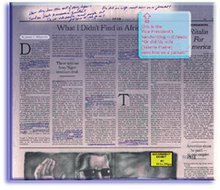





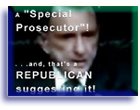












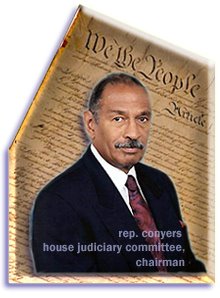
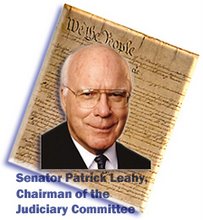

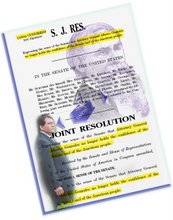
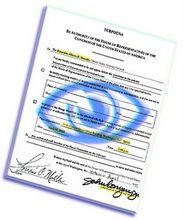











No comments:
Post a Comment